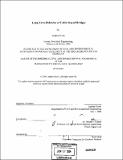Long term behavior of cable strayed bridges
Author(s)
Scotti, Andrea, 1978-
DownloadFull printable version (5.003Mb)
Other Contributors
Massachusetts Institute of Technology. Dept. of Civil and Environmental Engineering.
Advisor
Jerome J. Connor.
Terms of use
Metadata
Show full item recordAbstract
In the design of a structure, one of the most difficult parameter to assess is how the initial condition of a structure will change with time. During its life span, a structure can be subjected to different loads, changes in geometric configuration and even changes in its mechanical properties. Among all factors that can affect the geometrical reconfiguration of a structure (i.e. settlements and overloads) creep is one of the most important given its inevitability and because of its persistent effects (normally estimated as ten thousand days). Due to the effect of creep, a structure tends to amplify its deformation under a given load condition over time, and the final deformation can even reach values five or six time grater than the initial ones. During the design, the fact that deformations grow with time can be a difficult condition especially for highly indeterminate structures like cable stayed bridges where the stresses are related to the geometric configuration of the structure itself. In concrete cable stayed bridges, in fact, the increase in the deformation of the deck and the pylons over time leads to a decrease in the initial tension in the stays with an obvious difficulty in the design phase of the structure. The first chapter of this thesis illustrates and explains one approximate method used to estimate the effect of creep on a concrete structure. The method proposed in this thesis is the "Age-Adjusted Effective Modulus Method". It was chosen among others because it is one of the most commonly used, and because it is highly accessible. (cont.) In the second chapter, the Age-Adjusted Effective Modulus Method will be used in conjunction with the force method to study non homogeneous, indeterminate structure under the effect of creep. In this chapter a procedure will be introduced that enables the calculation of an initial value of the prestressing force in the stays that elides the effect of creep on tension. Bridge in Maine, USA (M.Eng Project. Alexander Otenti, Andrea Scotti, Richard Unruh III, 2004). The theory exposed in this thesis is a very powerful procedure that permits to simplification of the problem of creep in cable-stayed bridges, with easy calculations and with an iterative procedure.
Description
Thesis (M. Eng.)--Massachusetts Institute of Technology, Dept. of Civil and Environmental Engineering, 2004. Includes bibliographical references (leaf 46).
Date issued
2004Department
Massachusetts Institute of Technology. Department of Civil and Environmental EngineeringPublisher
Massachusetts Institute of Technology
Keywords
Civil and Environmental Engineering.